Dongha Lee
Imagine All The Relevance: Scenario-Profiled Indexing with Knowledge Expansion for Dense Retrieval
Mar 29, 2025Abstract:Existing dense retrieval models struggle with reasoning-intensive retrieval task as they fail to capture implicit relevance that requires reasoning beyond surface-level semantic information. To address these challenges, we propose Scenario-Profiled Indexing with Knowledge Expansion (SPIKE), a dense retrieval framework that explicitly indexes implicit relevance by decomposing documents into scenario-based retrieval units. SPIKE organizes documents into scenario, which encapsulates the reasoning process necessary to uncover implicit relationships between hypothetical information needs and document content. SPIKE constructs a scenario-augmented dataset using a powerful teacher large language model (LLM), then distills these reasoning capabilities into a smaller, efficient scenario generator. During inference, SPIKE incorporates scenario-level relevance alongside document-level relevance, enabling reasoning-aware retrieval. Extensive experiments demonstrate that SPIKE consistently enhances retrieval performance across various query types and dense retrievers. It also enhances the retrieval experience for users through scenario and offers valuable contextual information for LLMs in retrieval-augmented generation (RAG).
MT-RAIG: Novel Benchmark and Evaluation Framework for Retrieval-Augmented Insight Generation over Multiple Tables
Feb 18, 2025Abstract:Recent advancements in table-based reasoning have expanded beyond factoid-level QA to address insight-level tasks, where systems should synthesize implicit knowledge in the table to provide explainable analyses. Although effective, existing studies remain confined to scenarios where a single gold table is given alongside the user query, failing to address cases where users seek comprehensive insights from multiple unknown tables. To bridge these gaps, we propose MT-RAIG Bench, design to evaluate systems on Retrieval-Augmented Insight Generation over Mulitple-Tables. Additionally, to tackle the suboptimality of existing automatic evaluation methods in the table domain, we further introduce a fine-grained evaluation framework MT-RAIG Eval, which achieves better alignment with human quality judgments on the generated insights. We conduct extensive experiments and reveal that even frontier LLMs still struggle with complex multi-table reasoning, establishing our MT-RAIG Bench as a challenging testbed for future research.
Stop Playing the Guessing Game! Target-free User Simulation for Evaluating Conversational Recommender Systems
Nov 25, 2024Abstract:Recent approaches in Conversational Recommender Systems (CRSs) have tried to simulate real-world users engaging in conversations with CRSs to create more realistic testing environments that reflect the complexity of human-agent dialogue. Despite the significant advancements, reliably evaluating the capability of CRSs to elicit user preferences still faces a significant challenge. Existing evaluation metrics often rely on target-biased user simulators that assume users have predefined preferences, leading to interactions that devolve into simplistic guessing game. These simulators typically guide the CRS toward specific target items based on fixed attributes, limiting the dynamic exploration of user preferences and struggling to capture the evolving nature of real-user interactions. Additionally, current evaluation metrics are predominantly focused on single-turn recall of target items, neglecting the intermediate processes of preference elicitation. To address this, we introduce PEPPER, a novel CRS evaluation protocol with target-free user simulators constructed from real-user interaction histories and reviews. PEPPER enables realistic user-CRS dialogues without falling into simplistic guessing games, allowing users to gradually discover their preferences through enriched interactions, thereby providing a more accurate and reliable assessment of the CRS's ability to elicit personal preferences. Furthermore, PEPPER presents detailed measures for comprehensively evaluating the preference elicitation capabilities of CRSs, encompassing both quantitative and qualitative measures that capture four distinct aspects of the preference elicitation process. Through extensive experiments, we demonstrate the validity of PEPPER as a simulation environment and conduct a thorough analysis of how effectively existing CRSs perform in preference elicitation and recommendation.
Why These Documents? Explainable Generative Retrieval with Hierarchical Category Paths
Nov 08, 2024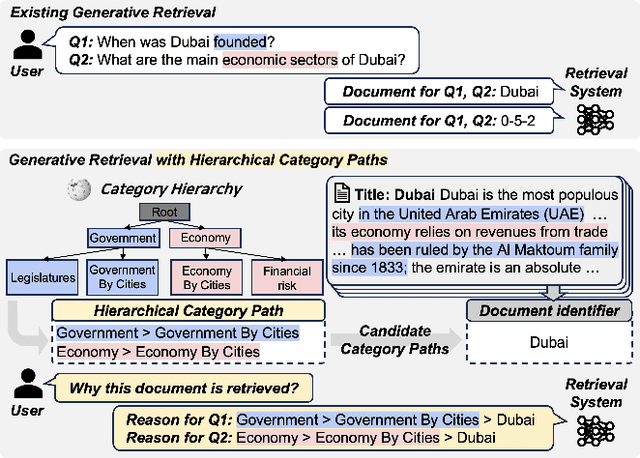
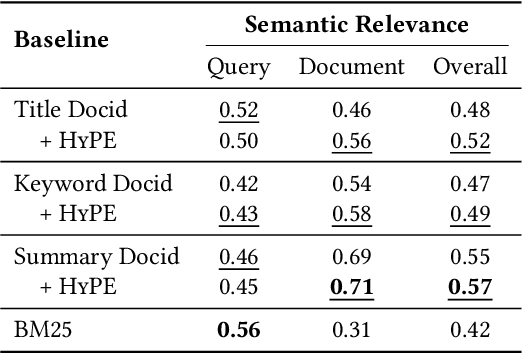
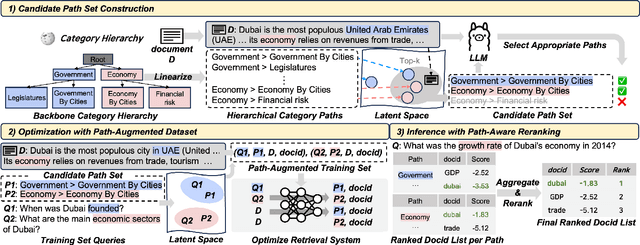
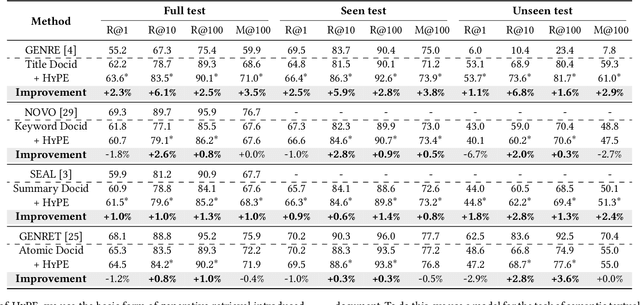
Abstract:Generative retrieval has recently emerged as a new alternative of traditional information retrieval approaches. However, existing generative retrieval methods directly decode docid when a query is given, making it impossible to provide users with explanations as an answer for "Why this document is retrieved?". To address this limitation, we propose Hierarchical Category Path-Enhanced Generative Retrieval(HyPE), which enhances explainability by generating hierarchical category paths step-by-step before decoding docid. HyPE leverages hierarchical category paths as explanation, progressing from broad to specific semantic categories. This approach enables diverse explanations for the same document depending on the query by using shared category paths between the query and the document, and provides reasonable explanation by reflecting the document's semantic structure through a coarse-to-fine manner. HyPE constructs category paths with external high-quality semantic hierarchy, leverages LLM to select appropriate candidate paths for each document, and optimizes the generative retrieval model with path-augmented dataset. During inference, HyPE utilizes path-aware reranking strategy to aggregate diverse topic information, allowing the most relevant documents to be prioritized in the final ranked list of docids. Our extensive experiments demonstrate that HyPE not only offers a high level of explainability but also improves the retrieval performance in the document retrieval task.
Taxonomy-guided Semantic Indexing for Academic Paper Search
Oct 25, 2024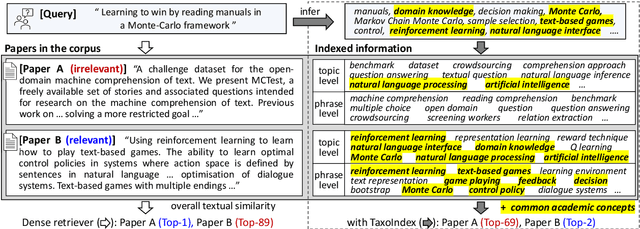
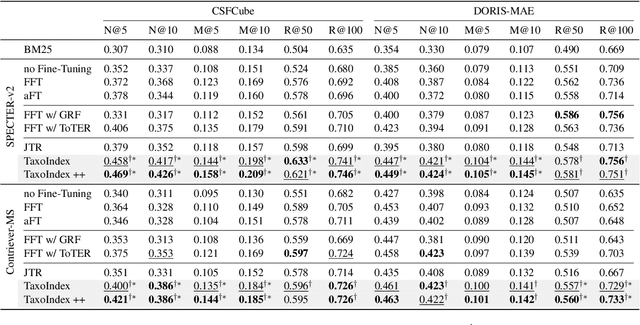

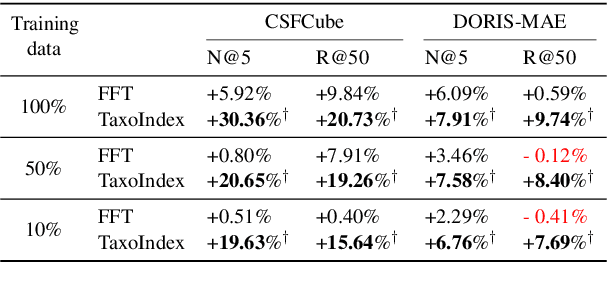
Abstract:Academic paper search is an essential task for efficient literature discovery and scientific advancement. While dense retrieval has advanced various ad-hoc searches, it often struggles to match the underlying academic concepts between queries and documents, which is critical for paper search. To enable effective academic concept matching for paper search, we propose Taxonomy-guided Semantic Indexing (TaxoIndex) framework. TaxoIndex extracts key concepts from papers and organizes them as a semantic index guided by an academic taxonomy, and then leverages this index as foundational knowledge to identify academic concepts and link queries and documents. As a plug-and-play framework, TaxoIndex can be flexibly employed to enhance existing dense retrievers. Extensive experiments show that TaxoIndex brings significant improvements, even with highly limited training data, and greatly enhances interpretability.
Can Code-Switched Texts Activate a Knowledge Switch in LLMs? A Case Study on English-Korean Code-Switching
Oct 24, 2024Abstract:Code-switching (CS), a phenomenon where multilingual speakers alternate between languages in a discourse, can convey subtle cultural and linguistic nuances that can be otherwise lost in translation. Recent state-of-the-art multilingual large language models (LLMs) demonstrate excellent multilingual abilities in various aspects including understanding CS, but the power of CS in eliciting language-specific knowledge is yet to be discovered. Therefore, we investigate the effectiveness of code-switching on a wide range of multilingual LLMs in terms of knowledge activation, or the act of identifying and leveraging knowledge for reasoning. To facilitate the research, we first present EnKoQA, a synthetic English-Korean CS question-answering dataset. We provide a comprehensive analysis on a variety of multilingual LLMs by subdividing activation process into knowledge identification and knowledge leveraging. Our experiments demonstrate that compared to English text, CS can faithfully activate knowledge inside LLMs, especially on language-specific domains. In addition, the performance gap between CS and English is larger in models that show excellent monolingual abilities, suggesting that there exists a correlation with CS and Korean proficiency.
Web Agents with World Models: Learning and Leveraging Environment Dynamics in Web Navigation
Oct 17, 2024Abstract:Large language models (LLMs) have recently gained much attention in building autonomous agents. However, the performance of current LLM-based web agents in long-horizon tasks is far from optimal, often yielding errors such as repeatedly buying a non-refundable flight ticket. By contrast, humans can avoid such an irreversible mistake, as we have an awareness of the potential outcomes (e.g., losing money) of our actions, also known as the "world model". Motivated by this, our study first starts with preliminary analyses, confirming the absence of world models in current LLMs (e.g., GPT-4o, Claude-3.5-Sonnet, etc.). Then, we present a World-model-augmented (WMA) web agent, which simulates the outcomes of its actions for better decision-making. To overcome the challenges in training LLMs as world models predicting next observations, such as repeated elements across observations and long HTML inputs, we propose a transition-focused observation abstraction, where the prediction objectives are free-form natural language descriptions exclusively highlighting important state differences between time steps. Experiments on WebArena and Mind2Web show that our world models improve agents' policy selection without training and demonstrate our agents' cost- and time-efficiency compared to recent tree-search-based agents.
Make Compound Sentences Simple to Analyze: Learning to Split Sentences for Aspect-based Sentiment Analysis
Oct 03, 2024Abstract:In the domain of Aspect-Based Sentiment Analysis (ABSA), generative methods have shown promising results and achieved substantial advancements. However, despite these advancements, the tasks of extracting sentiment quadruplets, which capture the nuanced sentiment expressions within a sentence, remain significant challenges. In particular, compound sentences can potentially contain multiple quadruplets, making the extraction task increasingly difficult as sentence complexity grows. To address this issue, we are focusing on simplifying sentence structures to facilitate the easier recognition of these elements and crafting a model that integrates seamlessly with various ABSA tasks. In this paper, we propose Aspect Term Oriented Sentence Splitter (ATOSS), which simplifies compound sentence into simpler and clearer forms, thereby clarifying their structure and intent. As a plug-and-play module, this approach retains the parameters of the ABSA model while making it easier to identify essential intent within input sentences. Extensive experimental results show that utilizing ATOSS outperforms existing methods in both ASQP and ACOS tasks, which are the primary tasks for extracting sentiment quadruplets.
Evaluating Robustness of Reward Models for Mathematical Reasoning
Oct 02, 2024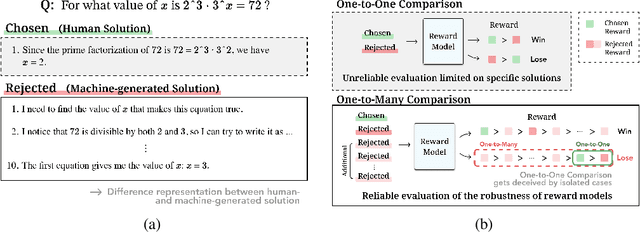
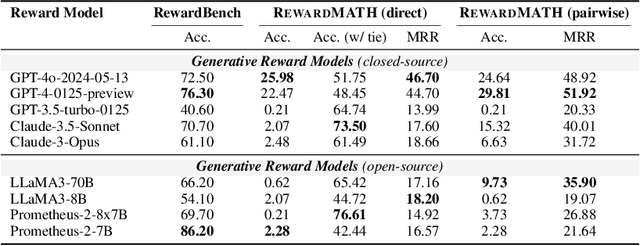

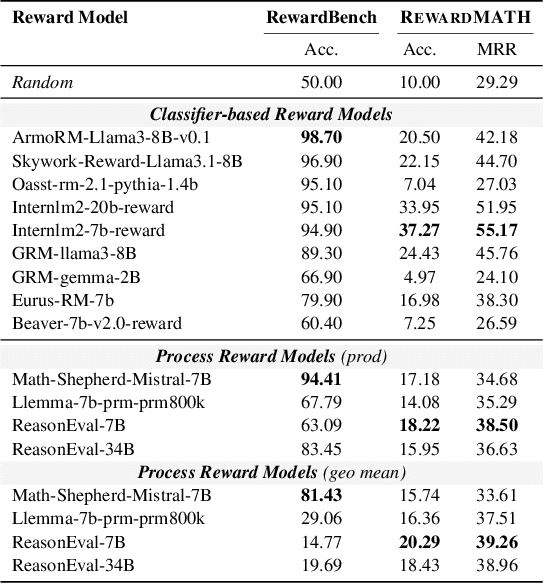
Abstract:Reward models are key in reinforcement learning from human feedback (RLHF) systems, aligning the model behavior with human preferences. Particularly in the math domain, there have been plenty of studies using reward models to align policies for improving reasoning capabilities. Recently, as the importance of reward models has been emphasized, RewardBench is proposed to understand their behavior. However, we figure out that the math subset of RewardBench has different representations between chosen and rejected completions, and relies on a single comparison, which may lead to unreliable results as it only see an isolated case. Therefore, it fails to accurately present the robustness of reward models, leading to a misunderstanding of its performance and potentially resulting in reward hacking. In this work, we introduce a new design for reliable evaluation of reward models, and to validate this, we construct RewardMATH, a benchmark that effectively represents the robustness of reward models in mathematical reasoning tasks. We demonstrate that the scores on RewardMATH strongly correlate with the results of optimized policy and effectively estimate reward overoptimization, whereas the existing benchmark shows almost no correlation. The results underscore the potential of our design to enhance the reliability of evaluation, and represent the robustness of reward model. We make our code and data publicly available.
Eliciting Instruction-tuned Code Language Models' Capabilities to Utilize Auxiliary Function for Code Generation
Sep 20, 2024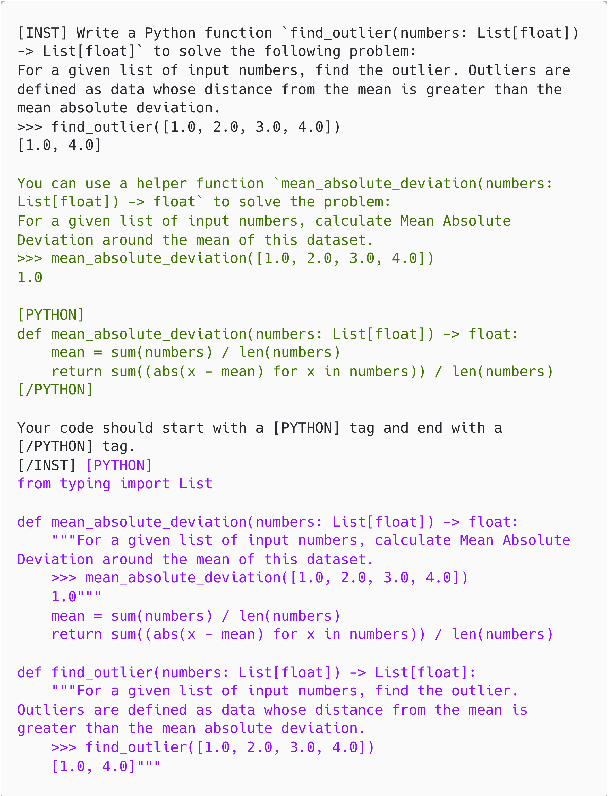

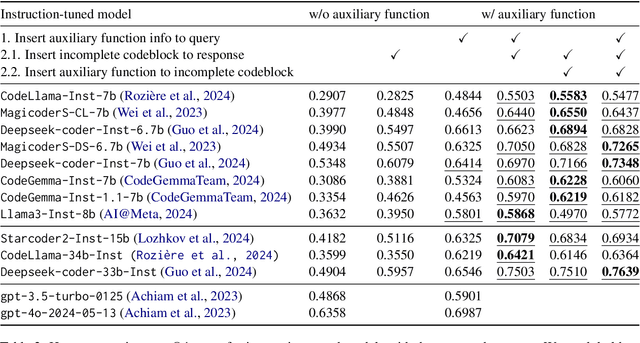
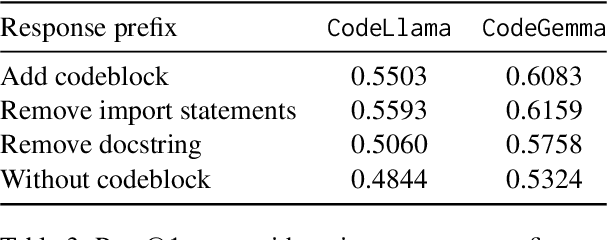
Abstract:We study the code generation behavior of instruction-tuned models built on top of code pre-trained language models when they could access an auxiliary function to implement a function. We design several ways to provide auxiliary functions to the models by adding them to the query or providing a response prefix to incorporate the ability to utilize auxiliary functions with the instruction-following capability. Our experimental results show the effectiveness of combining the base models' auxiliary function utilization ability with the instruction following ability. In particular, the performance of adopting our approaches with the open-sourced language models surpasses that of the recent powerful proprietary language models, i.e., gpt-4o.
 Add to Chrome
Add to Chrome Add to Firefox
Add to Firefox Add to Edge
Add to Edge